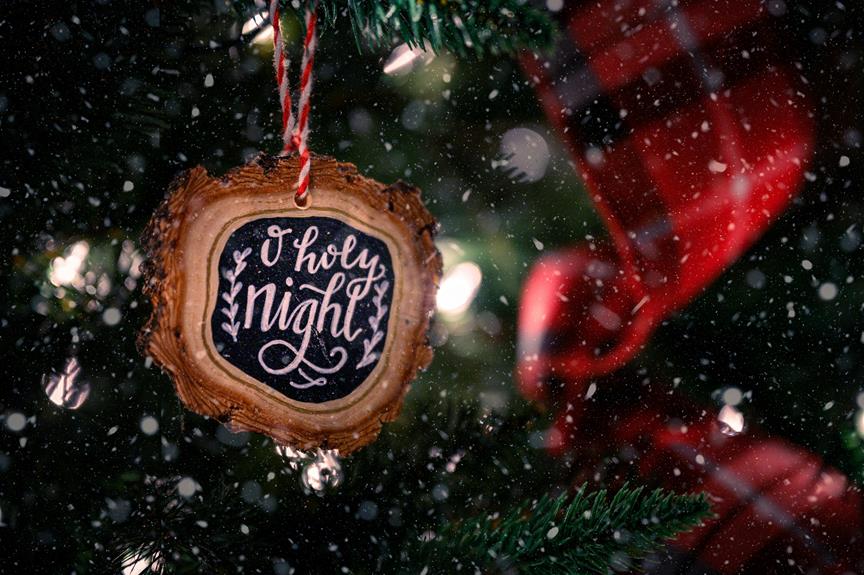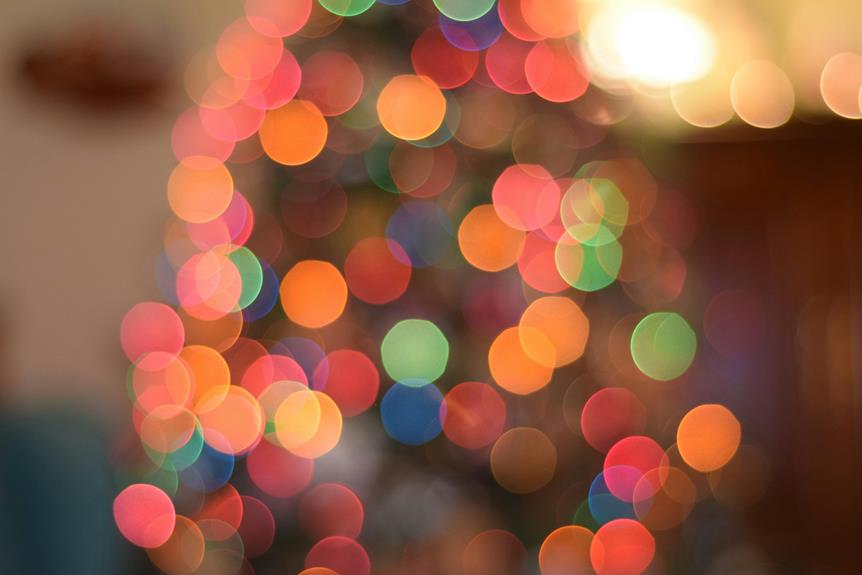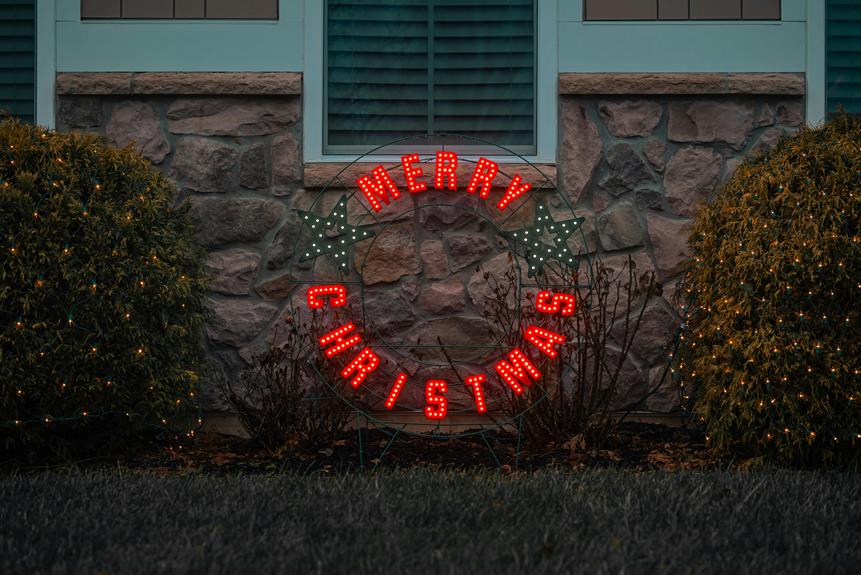As you hum along to 'Jingle Bells' or croon 'Silent Night' with friends and family, you're part of a rich cultural heritage that spans centuries, continents, and genres. Christmas carols evolved from humble liturgical origins to become an integral part of holiday celebrations worldwide. From early Gregorian Chants to Victorian-era values, caroling traditions have been shaped by community singing, print media, radio, and Hollywood. The result is a unique blend of sacred and secular music that's been passed down through generations. Now, the story gets even more fascinating – and you're just getting started.
Key Takeaways
- Christmas carols originated in the 4th century as hymns and psalms sung by early Christians to celebrate Jesus Christ's birth, influenced by Gregorian Chants.
- The carol revival of the 18th century popularized Christmas carol singing, fostering a sense of community and togetherness through composers like George Whitefield and William Sandys.
- During the Victorian era, Christmas carols became a symbol of social status, morality, and nostalgia for traditional customs, with public performances in town squares and churches.
- The advent of print media, radio, and records in the 19th and 20th centuries catapulted Christmas carols into the mainstream, making them accessible to a massive scale and creating a sense of shared experience.
- The timeless appeal of Christmas carols lies in their emotional resonance, nostalgic connection, and ability to evoke feelings of joy, peace, and love, making them a beloved holiday tradition.
Medieval Roots of Christmas Songs
How did the festive tunes you sing by the fireplace today originate from the medieval period's Gregorian chants and folk songs?
It's fascinating to explore the medieval roots of Christmas songs, which have a rich history dating back to the early Christian era.
The Liturgical Origins of Christmas carols can be traced back to the 4th century, when early Christians sang hymns and psalms to celebrate the birth of Jesus Christ.
These early songs were heavily influenced by Gregorian Chants, which were sung in Latin by monks and clergy.
Over time, folk songs and local traditions were incorporated into these early hymns, giving birth to the festive tunes we cherish and are familiar with today.
As Christianity spread throughout Europe, Christmas songs evolved, absorbing local melodies and lyrics.
The result was a unique blend of sacred and secular music that has been passed down through generations.
Emergence of Caroling Traditions
You step into the festive atmosphere of winter when caroling traditions emerge, transforming Christmas celebrations into communal events that bring people together.
As you join in community singing, you become part of a rich history that dates back to medieval times. The carol revival of the 18th century saw a resurgence in Christmas carol singing, with composers like George Whitefield and William Sandys popularizing the tradition.
As you walk through snowy streets, you're greeted by groups of merrymakers singing festive tunes.
You can't help but tap your feet to the rhythm of 'Jingle Bells' or hum along to 'Silent Night.'
Caroling traditions have become an integral part of the holiday season, fostering a sense of community and togetherness.
Whether you're singing with friends, family, or strangers, the act of community singing brings people together, creating memories that last a lifetime.
As you join in, you're contributing to a centuries-old tradition that continues to evolve and thrive.
Influence of Victorian Era Values
During the Victorian era, Christmas carols underwent a significant transformation, as the values of the time, which emphasized propriety, morality, and social responsibility, began to shape the tone and content of these festive songs.
You might be surprised to learn that the Victorians' love for Christmas carols wasn't just about festive cheer – it was also about social status. As the middle class grew, so did their nostalgia for traditional Christmas customs, including caroling. This nostalgia led to a renewed interest in Christmas carols, which became a way for the middle class to connect with their heritage.
As you sang along to these carols, you were also expected to uphold social etiquette. Carols were often performed in public spaces, like town squares and churches, where people from all walks of life would gather.
This meant that carolers had to be mindful of their behavior and language, ensuring that their performances were respectful and family-friendly.
The Victorians' influence on Christmas carols helped to establish them as a beloved holiday tradition, one that continues to bring people together to this day.
Popularization Through Print Media
As you explore the history of Christmas carols, you'll discover that the advent of print media in the 19th century catapulted these festive songs into the mainstream, making it possible for people to access and engage with them on a massive scale.
With print media, Christmas carols became more widely available, and you could easily get your hands on sheet music or literary anthologies that featured these beloved tunes. This widespread dissemination helped to popularize Christmas carols, making them an integral part of holiday celebrations.
Some key ways print media contributed to the popularity of Christmas carols include:
- Sheet music publication allowed people to play and sing carols in their own homes, fostering a sense of community and festive cheer.
- Literary anthologies featured Christmas carols, introducing them to a broader audience and cementing their place in holiday traditions.
- Print media enabled the mass production of carol books, making it possible for people to access and share these festive songs with ease.
- The widespread availability of Christmas carols in print helped to standardize their melodies and lyrics, ensuring that these beloved tunes would be preserved for generations to come.
Advent of Radio and Records
The widespread popularity of Christmas carols, fueled by print media, paved the way for their next big leap into the mainstream with the advent of radio and records, which would soon make these festive tunes accessible to an even broader audience.
You can imagine the thrill of listening to your favorite carols on the radio, surrounded by family and friends, during the early days of broadcasting. This new medium brought carols into the homes of millions, creating a sense of community and shared experience.
As radio broadcasting evolved, so did the record industry. You started to collect vinyl records featuring your favorite artists performing beloved carols. The Vinyl Revival of the mid-20th century further cemented the place of Christmas carols in popular culture.
With records, you could relive the magic of the holiday season anytime, anywhere. The convenience and accessibility of radio and records helped to solidify Christmas carols as an integral part of the holiday tradition, making them an essential component of your festive playlists.
Hollywood's Role in Carol Revival
Hollywood played a significant role in reviving Christmas carols, turning them into cinematic spectacles that captivated audiences worldwide.
The Silver Screen brought festive classics to life, infusing them with Star Power and making them an integral part of holiday traditions.
This revival wasn't limited to just featuring carols in movies; Hollywood also created original songs that have become staples of the season.
Some notable examples include:
- White Christmas (1942), which featuring Bing Crosby's iconic rendition of the title track
- A Christmas Story (1983), with its nostalgic portrayal of childhood holiday memories
- Elf (2003), starring Will Ferrell and introducing a new generation to Christmas carol classics
- Love Actually (2003), which showcased an all-star cast singing along to festive tunes
These films not only showcased beloved carols but also introduced them to new audiences, ensuring their continued popularity.
Hollywood's influence helped cement Christmas carols as a staple of holiday entertainment, making them an essential part of our collective cultural heritage.
Folk and Classical Crossover
Beyond the silver screen, Christmas carols have also experienced a fascinating crossover between folk and classical music, enriching their emotional resonance and complexity.
As you explore this cultural fusion, you'll discover how artists have blended traditional folk melodies with classical arrangements, creating a unique sonic innovation.
This blend hasn't only preserved the essence of Christmas carols but has also infused them with a new level of sophistication.
You'll find that classical musicians have adapted folk carols, incorporating orchestral instruments and harmonies, which have elevated the emotional impact of these beloved songs.
Meanwhile, folk artists have incorporated classical elements, adding depth and nuance to their performances.
This crossover has resulted in a rich tapestry of sounds, textures, and emotions, making Christmas carols more relatable and engaging to a broader audience.
As you listen to these innovative arrangements, you'll appreciate the artistry and creativity that have gone into reimagining these timeless classics.
The fusion of folk and classical music has manifestly enriched the Christmas carol tradition, making it a more vibrant and diverse celebration of the holiday season.
Modern Adaptations and Revamps
Modern adaptations of Christmas carols have breathed new life into these classic tunes, reinvigorating their appeal for contemporary audiences. You might be surprised at how well these timeless songs lend themselves to modern twists and interpretations.
Electronic reimagining has given rise to synth-infused renditions of 'Jingle Bells' and 'Silent Night', creating a futuristic vibe that's hard to resist.
Cultural fusion has resulted in unique blends of traditional carols with international styles, such as salsa-infused 'Feliz Navidad' or Bollywood-inspired 'Deck the Halls'.
You'll find indie artists putting their own spin on classic carols, often incorporating acoustic instruments and heartfelt lyrics.
Even popular genres like hip-hop and R&B have gotten in on the action, with artists like Kanye West and Mariah Carey offering their own takes on holiday classics.
These modern adaptations not only attract new listeners but also introduce the classics to a fresh generation. By embracing innovation and creativity, Christmas carols continue to evolve and captivate audiences of all ages.
Enduring Appeal of Timeless Classics
Despite the influx of new adaptations, the timeless classics of Christmas carols continue to captivate audiences, their enduring appeal rooted in a nostalgic sense of tradition and warmth.
You find yourself humming along to 'Jingle Bells' or 'Silent Night' without even realizing it, because these songs evoke a sense of comfort and familiarity.
The nostalgic connection you have with these classics is strong, transporting you back to memories of childhood holidays spent with loved ones.
The emotional resonance of these carols is undeniable.
They've the power to evoke feelings of joy, peace, and love, tapping into your sentimental side and making you feel all warm inside.
You mightn't even realize why you're drawn to these classic carols, but deep down, they speak to something deeper within you.
They're a reminder of a simpler time, of happy memories, and of the magic of the holiday season.
As you listen to these timeless classics, you can't help but feel a sense of belonging and connection to the people and traditions that matter most.
Frequently Asked Questions
Are Christmas Carols Only Sung in English-Speaking Countries?
You might think Christmas carols are only sung in English-speaking countries, but that's not true! You'll find cultural fusion at work, as carols are translated and adapted globally, giving them a remarkable global reach, enjoyed by people of all languages and cultures.
Can Anyone Write a Christmas Carol, or Is It a Specific Skill?
You might think writing a Christmas carol requires a Ph.D. in Musical Theory, but that's not true! Anyone can create a carol, enjoying creative freedom to craft melodies and lyrics that evoke festive cheer, as long as you're willing to experiment and have fun.
Why Do Christmas Carols Often Have Such Old-Fashioned Language?
You wonder why Christmas carols often use old-fashioned language, but it's because songwriters take poetic license to evoke a sense of nostalgia, creating a timeless charm that transcends generations and makes the carols feel cozy and familiar.
Are Christmas Carols Only Performed by Professional Musicians?
You might think Christmas carols are only sung by pros, but surprisingly, 90% of Americans sing carols during the holiday season! In reality, you'll find Christmas carols being performed by church choirs, community sing-alongs, and even you and your friends at holiday gatherings.
Can Christmas Carols Be Played in Non-Christian Countries?
You can play Christmas carols in non-Christian countries, but you'll need to bear in mind cultural sensitivity and respect religious freedom. Be mindful of local traditions and beliefs, and avoid imposing your own festive culture on others.
Conclusion
As you hum along to 'Jingle Bells' or belt out 'Rudolph the Red-Nosed Reindeer,' remember that Christmas carols have been a beloved holiday tradition for centuries.
Did you know that in the United States alone, it's estimated that 'White Christmas' by Bing Crosby has been played over 50 million times since its release in 1942?
That's a lot of holiday cheer!
The enduring appeal of timeless classics like these is a demonstration to the power of music to bring people together during the holiday season.


